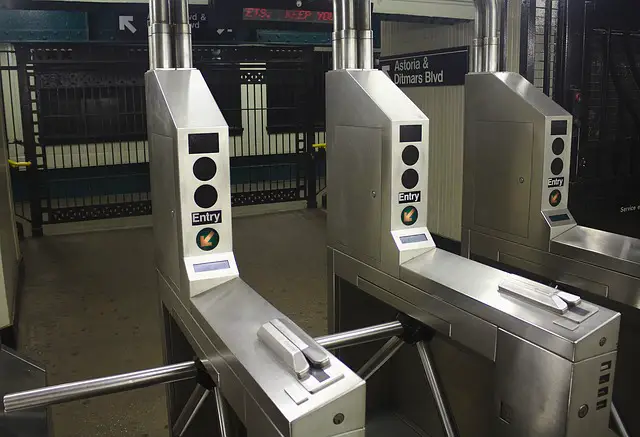With mob violence and security threats on a rise all around the world, ensuring safety has become a rising concern. Whether it is about putting robust safeguards in the virtual world or the physical one, an increasing number of people are acknowledging the need for enhanced security measures.
When it comes to improving security in public places, you can depend on turnstile gates. Turnstiles can be defined as “a structure of four horizontally revolving arms pivoted atop a post and set in a gateway or opening in a fence to allow the controlled passage of people.”
It is a “gate which allows one person to pass at a time. It can also be made so as to enforce one-way traffic of people, and in addition, it can restrict passage only to people who insert a coin, a ticket, a pass, or similar.”
Installing turnstile gates at entry/exit points in public places stringently enhances access control, thereby improving security and promoting safety. These gates enable establishments such as railway stations, airports, parks, theatres, malls, museums, and offices to secure their premises for years to come. Let’s see how these gates are improving security in public places.
1. Advanced Access Control
Even though normal gates enable controlled access of people with physical and/or digital locks, they’re ineffective in controlling the number of people who can enter a premise at a time.
This may give rise to tailgating, a pervasive security issue where an individual tries to trail illegally behind a person who is authorized to enter a particular building/area. This in happens in most public places.
Moreover, a regular gate isn’t equipped to count the numbers of entries or exits. An unauthorized person can easily attempt an entry/exit just as an authorized person enters the premises.
Turnstile gates can fix this loophole. They are effective in curbing tailgating by making it impossible for more than one person to enter a secure premise at a time. These gates are ideal for use at places like stadiums and theatres, where ticketed public events take place.
The most important advantage of turnstile gates is they offer advanced access control to avert and detect unauthorized entrants. This is achieved by allowing one-sided traffic with the help of a biometric passes or cards. These passes/cards, in turn, permit to only one person to enter at a time.
With only one person approved to access the premises at a time, the rate of footfalls decreases, which gives security personnel sufficient time to pinpoint troublemakers and intervene accordingly.
2. Integration with Existing Security Systems
Most public office buildings these days already have some form of security system and equipment in place. These are usually in the form of security cameras. Modern turnstile gates can aid and improve security initiatives by easily integrating with the already installed systems in place.
They are capable of syncing with the preinstalled cameras to identify individuals and the time of their entry. This information can be used to block suspicious individuals from entering the building in the future. Turnstile gates can also be integrated with existing alarm systems and other security controls to enable and boost fail-safe public safety.
3. Catering to All Security
Needs One of the amazing things about turnstile gates is that they’re embedded with multiple readers that authorize people for entry. In this way, these gates cater to all security needs of the area where they’re installed while easing human workload and saving time as well as costs.
For example, in railway stations and airports, gates installed at the entrance can be programmed to strictly permit people to only enter, while gates installed at the exit allow them only to exit. This helps record every single footfall in these areas. Moreover, these gates can be locked at night after hours of operations, leaving these public places safe and secure.
4. Enforcing Payments Where Required
Public venues often become hotspots for unmanageable crowds, which is why turnstile gates can be useful here. Places that mandate buying tickets or making a payment for access, such as museums, parks, stadiums, public transport stations, can make good use of these gates to ensure legitimate entry through guaranteed payment enforcement. Turnstile gates will unlock and admit a single person at a time only when they scan and detect a valid, paid-for ticket, rendering the area safe.
5. Adherence to ADA
The ADA is a “civil rights law that prohibits discrimination against individuals with disabilities in all areas of public life, including jobs, schools, transportation, and all public and private places that are open to the general public.”
The good news is that some types of turnstiles gates are ADA-compliant. ADA-compliant gates come with a wide passageway that allows wheelchairs to pass through it. Security gates with ADA-compliant width can also be installed next to the turnstile.
These gates can help maintain optimal security in public areas while treating the disabled with respect and integrity. Conclusion The above points make it amply clear that turnstile gates are the future of advanced security and access control. After all, they’re highly reliable and sync with multiple technologies to identify people based on their codes and the time to measure the exact traffic.
Installing turnstile gates in high-traffic public places goes a long way in eliminating man-made errors and forestalling security issues by blocking unauthorized entries/exits. It is, therefore, advised to install these gates and record the entry/exit of every individual accessing a particular public space.

